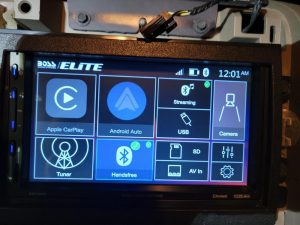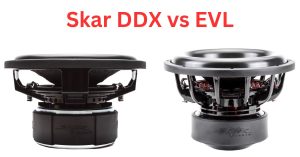Car audio enthusiasts understand the joy of a powerful, well-balanced sound system, and achieving this begins with the harmonious marriage of a subwoofer and amplifier. In the world of car stereo systems, the “match subwoofer to amp calculator” becomes an invaluable tool. In this article, we’ll delve into the importance of matching your subwoofer to the right amplifier, offering insights into the basics, practical tips, and a step-by-step guide using a calculator.
As an avid car audio enthusiast, I’ve experienced the transformative impact of a well-matched subwoofer and amplifier. The clarity, depth, and richness of the sound are unparalleled when the components are perfectly tuned to each other. Conversely, the frustration of mismatched equipment, with distorted bass and potential damage to the system, underscores the importance of understanding and utilizing a reliable calculator.
Contents
Understanding the Basics
The Role of the Subwoofer
Subwoofers are dedicated to reproducing low-frequency sounds or bass. Their ability to handle and reproduce these frequencies contributes significantly to the overall audio experience. When choosing a subwoofer, consider factors such as power handling capability, impedance, and sensitivity.
Amplifiers and Sound Quality
Amplifiers play a crucial role in boosting the audio signal to drive speakers, including the subwoofer. The power output, impedance compatibility, and understanding the difference between RMS (Root Mean Square) and peak power are essential when selecting an amplifier.
Why Matching Is Crucial
Mismatched subwoofers and amplifiers can lead to various issues, including distorted sound, overheating, and potential damage to the equipment. Matching ensures optimal performance, efficient power usage, and a longer lifespan for your car audio system.
Selecting the Right Subwoofer and Amp
Factors to Consider When Choosing a Subwoofer
1. Power Handling Capability
The power handling capability of a subwoofer refers to the amount of power it can handle without distortion. Choosing a subwoofer with a power handling capacity that aligns with your amplifier’s output is crucial for preventing damage and ensuring clean, powerful bass.
2. Impedance
Impedance, measured in ohms, is the resistance the subwoofer presents to the amplifier. Ensure that the subwoofer’s impedance is compatible with the amplifier to avoid mismatch issues.
3. Sensitivity
Sensitivity specifies how efficiently a subwoofer converts power into sound. Higher sensitivity values require less power to produce the same volume level, making them suitable for lower-powered amplifiers.
Amp Specifications to Keep in Mind
1. Power Output
Selecting an amplifier with an appropriate power output is vital. Ensure that the amplifier’s wattage matches the subwoofer’s power handling capability to avoid overpowering or underpowering the subwoofer.
2. Impedance Compatibility
Match the amplifier’s impedance capabilities with the subwoofer. Connecting an amplifier with a different impedance can result in poor performance and potential damage.
3. RMS vs. Peak Power
Understanding the difference between RMS and peak power is crucial. RMS power represents the continuous power the amplifier can handle, while peak power indicates the maximum power it can handle for short bursts. Aim for a balance that suits your listening preferences and the subwoofer’s specifications.
The Match Subwoofer to Amp Calculator: A Practical Guide
Introduction to the Calculator Tool
The “match subwoofer to amp calculator” simplifies the process of finding the optimal match for your car audio system. This online tool considers various factors, including subwoofer and amplifier specifications, to provide recommendations for an ideal pairing.
Step-by-Step Guide on Using the Calculator
1. Entering Subwoofer Specifications
Begin by entering key subwoofer specifications, such as power handling capability, impedance, and sensitivity. This information is often available in the subwoofer’s manual or on the manufacturer’s website.
2. Adjusting Amplifier Settings
Input the amplifier specifications, including power output, impedance compatibility, and whether it operates in mono or stereo mode. This ensures the calculator considers the amplifier’s capabilities when generating recommendations.
3. Interpreting the Results
The calculator will provide suggestions based on the entered specifications. Look for matches that align with both the subwoofer and amplifier requirements. Pay attention to details such as recommended power range, impedance compatibility, and sensitivity.
Practical Example: Matching a 12-Inch Subwoofer to a 500-Watt Amplifier
Let’s delve into a practical scenario to understand the importance of using a “match subwoofer to amp calculator.” Consider a 12-inch subwoofer with the following specifications:
| Specification | Value |
| Power Handling Capability | 600 watts RMS |
| Impedance | 4 ohms |
| Sensitivity | 85 dB |
Now, you also possess a 500-watt amplifier with a 4-ohm impedance capability. To ensure a seamless integration of these components, let’s utilize the calculator and input the relevant values:
| Subwoofer Specifications | Amplifier Specifications |
| Power Handling Capability | 600 watts RMS |
| Impedance | 4 ohms |
| Sensitivity | 85 dB |
| Amplifier Power Output | 500 watts |
| Amplifier Impedance | 4 ohms |
Upon entering these specifications into the calculator, you receive recommendations that fall within the safe and optimal range for both components. This ensures a balanced and powerful audio experience, eliminating the risk of damage to either the subwoofer or the amplifier.
By leveraging the calculator, you gain insights into the compatibility of these components, allowing you to make informed decisions for a well-matched and high-performing car stereo system.
FAQs for Better Understanding
1. Can I Use Any Subwoofer with Any Amplifier?
While some flexibility exists, it’s crucial to match the power handling capability, impedance, and sensitivity for optimal performance and longevity. Using a calculator helps in finding compatible combinations.
2. What Happens if I Mismatch My Subwoofer and Amp?
Mismatching can lead to distorted sound, reduced performance, overheating, and potential damage to the subwoofer or amplifier. It’s essential to ensure compatibility.
3. How Do I Determine the Impedance of My Subwoofer?
Check the subwoofer’s manual or the manufacturer’s website for impedance information. It’s usually expressed in ohms and represents the resistance the subwoofer presents to the amplifier.
4. Is Peak Power or RMS Power More Important When Matching?
Both are important. RMS power reflects continuous power handling, while peak power indicates the maximum power the components can handle in short bursts. Aim for a balance that suits your listening preferences and system specifications.
Tips and Tricks for Optimal Performance
1. Properly Setting Gain and Crossover Settings
Fine-tune your system by setting the gain and crossover settings appropriately. This ensures that the amplifier sends the right frequencies to the subwoofer, optimizing the audio output.
2. Understanding the Acoustics of Your Car Interior
The acoustics of your car interior play a significant role in the overall audio experience. Experiment with subwoofer placement and adjust settings based on the unique characteristics of your vehicle’s interior.
3. Regular Maintenance and Checking for System Compatibility
Perform regular checks on your subwoofer and amplifier to ensure they are functioning optimally. Revisit the calculator if you make any changes to your system, such as upgrading components.
Conclusion
In the pursuit of a powerful and immersive car audio experience, the importance of matching your subwoofer to the right amplifier cannot be overstated. Utilizing the “match subwoofer to amp calculator” ensures that you make informed decisions, preventing potential issues and unlocking the full potential of your car stereo system. As you embark on this journey, remember that a well-matched setup not only delivers exceptional sound but also protects your valuable audio equipment for the long haul.






